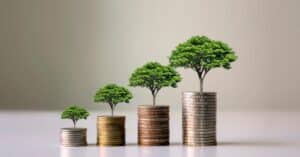For anyone running a business in the 21st century there is no longer a question about whether to create a sustainability strategy.
The only concern for sustainability managers or CEOs should be how to make this strategy effective to meet the challenges of today and agile enough to meet the demands of tomorrow.
Key Points:
- The challenges of climate change are already here on our doorstep, with severe weather, resources under strain and natural disasters now a regular occurrence.
- To avoid a 2°C rise in global temperature, the average carbon footprint needs to reduce to less than 2 tonnes by 2050. This includes businesses, whose activities are widely regarded to be responsible for most climate change.
- We can only hope to slow down this decline in time – and learn fast enough to begin making a positive impact on the environment instead of continually causing harm.
How to start creating a sustainable strategy
There is not a one-size-fits-all sustainability strategy to cover every business.
Every business is different and the amount of waste, emissions and options for finding alternative energy, resources or transport will differ from business to business.
- The best place to begin is to conduct an environmental audit of your business, capturing essential data, knowledge and intel from different staff and departments.
- The more open and transparent you are in admitting where the business is going wrong where it comes to the environment, the better your chances of making a real, meaningful and lasting change.
- Stakeholder buy in is also essential, at all levels of the organisation. Encouraging all staff to work together to protect the environment through a strong internal communications strategy with regular activities and updates is also a great way to boost morale and employee loyalty.
- In addition to common goals as a company, each individual employee should be encouraged to meet their own personal goals. For example, the business could set challenges regarding recycling or community clean-up operations with rewards for the highest achievers.
Listen to our training experts discuss how your business can become more sustainable, in our green skills podcast
4 steps to creating a sustainable strategy
#1. Start reducing waste and emissions
With data and insight at your disposal, the next step is to find solutions to limit the waste and emissions specific to your business activities.
Although at first there might be extra costs involved in reassessing processes and finding sustainable alternatives, it is also the case that increasing efficiency and streamlining processes is always good for any business. Waste costs – unless you can utilise that waste to fuel another business activity.
#2. Regular monitoring & adjusting
Monitoring is also key, so that you can measure the impact of any changes and adjust them if necessary. Your colleagues can act as your eyes and ears across the business, so encourage an open culture of no blame reporting and you will soon discover the benefits.
#3. Upskilling your staff
Investing in green skills will also mean that responsibility for sustainability does not sit with one person or department. At TSW Training, we offer a range of IEMA courses so your staff can keep up-to-date with government legislation relating to the environment and specifically net zero targets, as well as giving them the skills to identify problems within your organisation and find lasting solutions.
Each course equips learners with knowledge of compliance surrounding environmental skills, the risks your business may encounter without adequate environmental credentials and the techniques and strategies you can apply at a strategic or operational level to achieve environmental goals and solve problems relating to poor sustainability.
For businesses, IEMA qualifications signal a profitable green transition and a positive push towards net zero. This equips the company with efficient, green processes and an environmentally resilient strategy. It also gives you knowledge of existing legislation and compliance, as well as preparing the business for any changes.
#4. Provide regular reports & updates
Regular updates and reporting will also feed into follow-up environmental audits. Making the information widely available will put your company in good stead with customers, as they will appreciate seeing real efforts being made to help the environment, rather than the greenwashing that might be coming from competitors.
Future plans
So you’ve completed your environmental audit, identified a couple of issues and implemented a waste reduction policy – job’s done now, right?
A sustainability strategy cannot be successful if it’s viewed as a box-ticking exercise. It should be reviewed and revisited, tweaked and improved to evolve and respond to new challenges and opportunities.
Real progress, backed by both scientific data and anecdotal evidence, can not only help your business to survive but thrive.
In these uncertain times, those businesses who fail to properly prepare for the challenges ahead could find themselves left behind.







